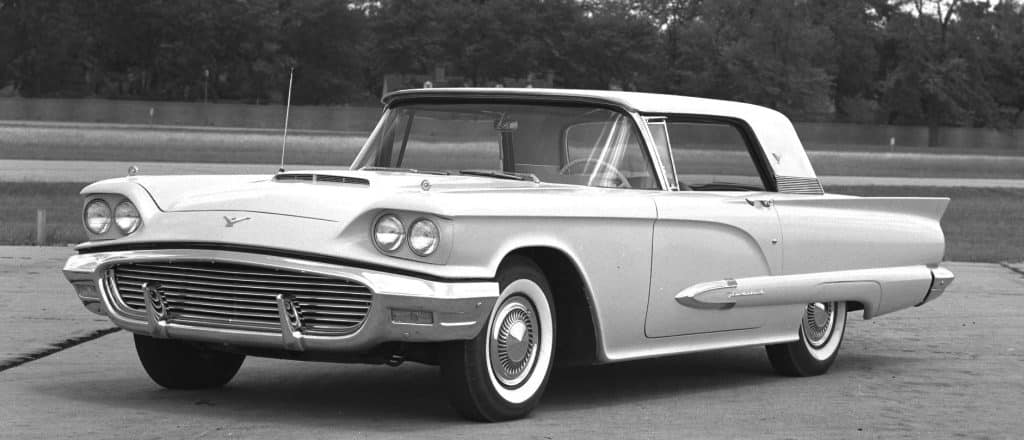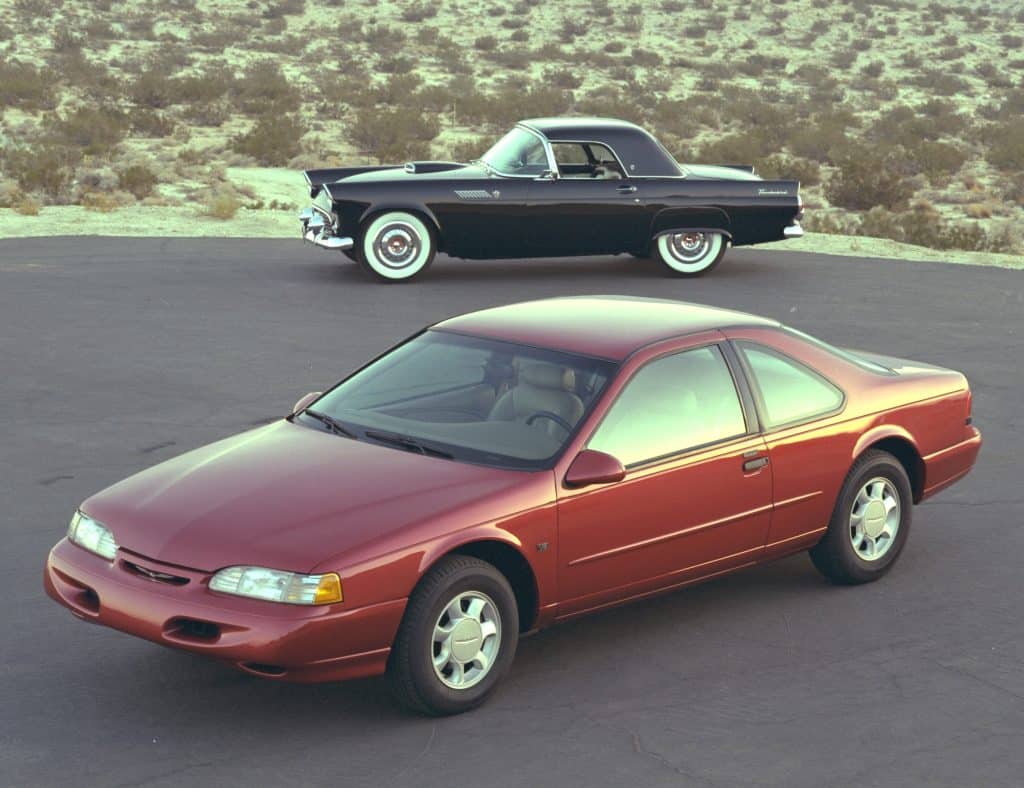Although it is almost twenty years since the Thunderbird name last appeared in the Ford model line-up, it remains linked to a true automotive icon. It has lived in the hearts and minds of enthusiasts, and in the garages of collectors, for decades. That icon is the original “T-Bird” which appeared as a prime contender for the title of the definitive American sports car in 1955.
Since then, the Ford Thunderbird story has covered eleven generations of styling. Long after the classic sports cars were gone, it included four-seater roadsters, convertibles, hardtops and luxury four-door models. Almost five million of them were sold over the fifty years that the Thunderbird was in the Ford catalogue but, while most of the models since 1960 were generally forgettable, the two-seaters of the mid-1950s never will be.
1954 Detroit Auto Show
The initial 1953 guidelines for Ford’s first interpretation of a European-style sports car called for a two-passenger, convertible that would make maximum use of standard production components. Design objectives included:
- a weight of no more than 2,500 pounds
- a V-8 engine
- balanced weight distribution
- acceleration better than the competition
- a top speed of more than 100 miles per hour
The resulting Ford Thunderbird made its first public appearance in February 1954, at the first post-war Detroit Auto Show. The first car came off the production line in September of that year and went on sale a month later, listed as a 1955 model.
The original Thunderbird was a racy two-seater with clean, crisp lines and was an immediate smash hit. The public went for the Ford Thunderbird in a big way, placing more than 3,500 orders in the first 10-day selling period when the planning volume for the entire model year was only 10,000 units. Ford had explored an uncharted market for America and had come up with a winner.

1955 Thunderbird
The original Ford Thunderbird convertible in 1955 was an immediate success
But despite its popularity, the flight of the two-seater T-Bird would be a short one. There were changes almost immediately after the car was introduced. The original design presented some problems. The cockpit needed better ventilation. Rear-quarter vision had to be improved. More luggage space was a necessity.
Design changes on 1956 models corrected these deficiencies. Side vents provided better ventilation while porthole windows in the hard-top enhanced rear vision and an outside tire carrier freed up extra trunk space. Those portholes have since become iconic in their own right.

The T-Bird’s upgrades for 1957 included a detachable hard-top with the now iconic ‘porthole’ windows that added even more to the car’s charisma.
The T-Bird’s upgrades for 1957 included a detachable hard- top with the now iconic ‘porthole’ windows that added even more to the car’s charisma
The 1957 T-Bird would be the last of the two-seaters. The last one rolled off the assembly line December 13, 1957 and an era had ended. Seldom in the history of the automobile industry has a company achieved the immediate success that Ford reached in creating the Thunderbird. The car stunned the automotive world and the effect was a lasting one. Not for nothing has the “T-Bird” name become established as an automotive legend, Those early Thunderbirds gave to the world a handsome car that was entirely in the American idiom – a practical and enjoyable car for both daily transportation and long trips, and a stylish, yet unique sporting machine with excellent performance and intriguing pedigree.

1957 Thunderbird
The 1957 model was the last of the legendary Ford Thunderbird two-seaters
That is why it begs the question as to why Ford management decreed that the Thunderbird’s future for the next four decades belonged to the four-seaters. After all, the two-seater had certainly given Ford the prestigious car it needed and sales had exceeded planning volumes in each of the three years it was on the market.
Ford’s market research, however, had come up with the conclusions that the economic realities of the times, combined with the public’s motoring needs and Ford’s market share, inhibited the potential of the car. That marketing research firstly pointed out the blindingly obvious fact that two-seaters were not being purchased by families with children, unless as a second car.
Thus the seating capacity and price restricted Thunderbird ownership to multi-car, upper income families. The next point made was that a four-passenger car would broaden the market to include the upper-income single car-owner group – also an obvious conclusion.
Finally, the researchers forecast that a significant amount of two-seater owners were interested in a four-passenger model so long as Thunderbird styling was maintained. That point was debatable but, armed with this rationale, Ford ushered in the new 1958 year by unveiling the four-passenger Thunderbird.

1958 Thunderbird
1958 Ford Thunderbird
By 1958 the T-Bird had morphed into a flashy four-seater boulevard cruiser that retained only hints of its predecessor’s classic style.
The stylists had done their best to retain the classic lines of the original Thunderbird but the signs were obvious that Ford had moved a long way from its original concept of an American sports car. Automotive historians and enthusiasts have since postulated that Ford management had rolled over and shied away from any confrontation with the Chevrolet Corvette that had gone on sale in 1953, although the Corvette initially sold very poorly.
In its initial planning stages Ford had felt that the T-Bird had the advantage over the Chevrolet by virtue of it having V8 power as against the pedestrian inline six-cylinder unit in the rival ‘Vette. Especially as sales of those first Corvette options were demonstrably poor. But when Ford launched the Thunderbird in 1955 then Chevrolet immediately countered by equipping the Corvette with its own V8 – the now much-revered 327cu.ins. (5.7 litres) ‘small-block’ motor.
In the initial head-to-head rivalry in the battle of the giants for the bragging rights for the building of “America’s sports car” both claimants to that title enjoyed great success in 1955 and 1956. Obviously there was room in the market for such a car but was that section of the market big enough to pay dividends? Was there a long-term future for an American sports car? And, more importantly, was there room enough for two contenders for the title?
In the duel between the two giants, Ford blinked first. It folded up its sports car plans and left that field to Chevrolet. The 1958 Thunderbird was classified by Ford as a “semi-luxury” car and all subsequent versions of the car remained squarely in that mass-market sector.

1959 Thunderbird
The 1959 & 1960 models were aimed at luxury car buyers

1960 Thunderbird
The re-styled T-Birds of the mid-1960s were still cruisers rather than sports car ‘bruisers’ but became popular with collectors over the years.
Was Ford’s decision to abandon the sports car market the correct one? It could be said that, in the duel to produce “America’s sports car” to the victor went the spoils as the Corvette has been Chevrolet’s glamorous line leader from 1953 to the present day. Indisputably, for over 70 years it has worn the crown of being the producer of America’s only high-volume sports car.
On the other hand, there is plenty of evidence to confirm that Ford management’s decision to put head above heart and follow the dictates of its market research was also a correct one. After all, the Thunderbird name remained in the Ford model line-up for a full fifty years and was therefore an economic success, even though all models since 1957 were essentially forgettable.

1963 Thunderbird
1971 Ford Thunderbird
The 1971 Thunderbird was just another big American car with no readily identifiable character of its own. And it remained so for the next three decades until Ford paid 21stCentury homage to the 1950s classics.
When people refer to the T-Bird as an icon, it is the cars built between 1955 & 1957 that are in their mind and Ford recognized that by using its charisma to help advertise their current models in the 1980s and ‘90s.

1995 Thunderbird
Finally, as a postscript to the Thunderbird story, when Ford showed a concept car at the 1999 Detroit Auto Show to underline its heritage, it was on the 1950s T-Birds that it drew for its styling cues. So positive was the public reaction to the concept car that it was put into limited production in 2002 and remained in the Ford model range for three more years. More than 50 years after it had itself appeared at the 1954 Detroit Auto Show, the original T-Bird was still influencing 21st century customers.

Thunderbird Concepts
Words: Bruce Cox
Photographs Courtesy of Ford Motor Company


